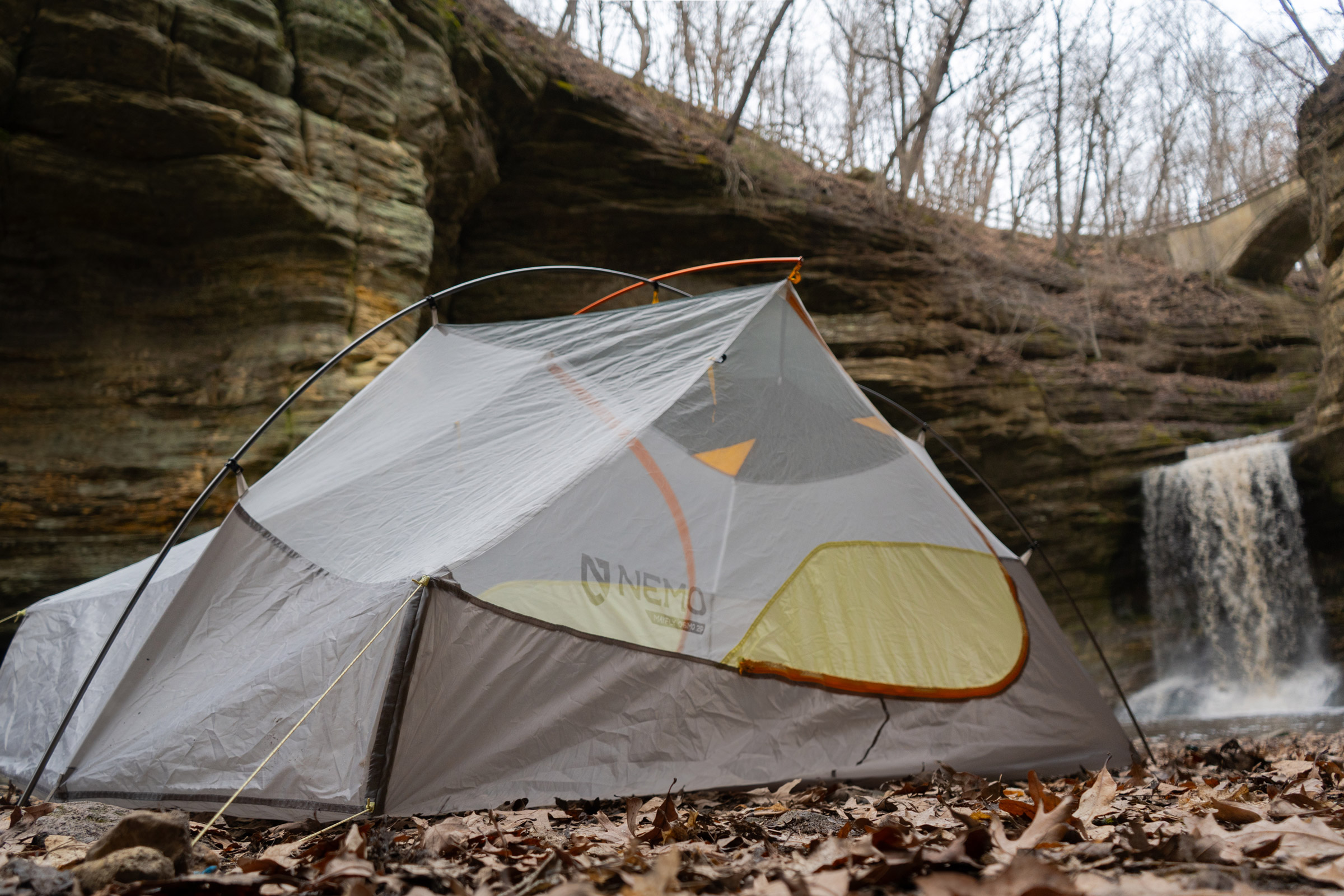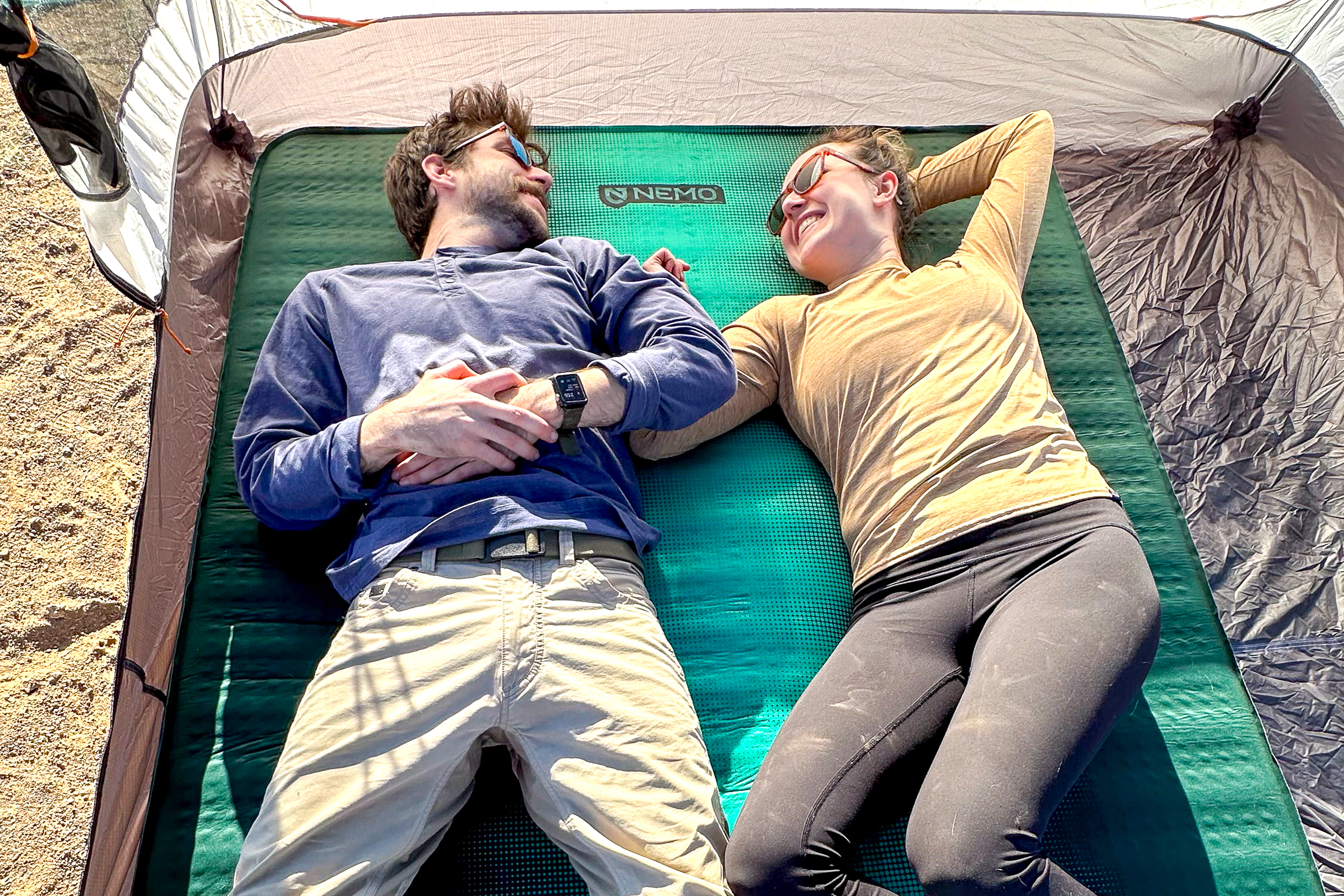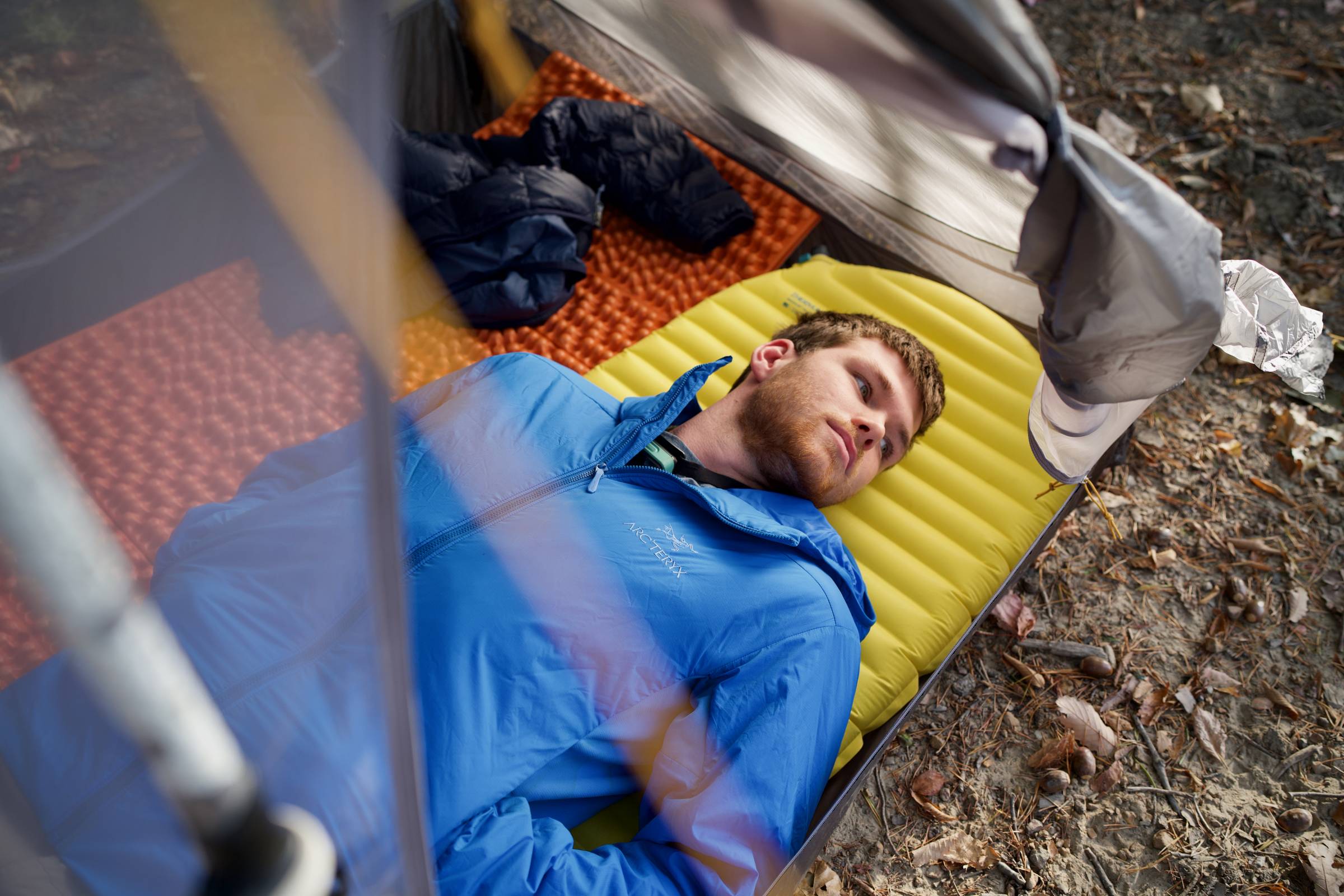The more I gear I test the more I find myself starting sentences with, “I’m not ultralight but …”
NEMO’s new Mayfly OSMO would introduce itself the same way. Only, it can end that statement with, “You’ll love me anyway.”
As someone with a sweet spot for modifying cheap gear, I wouldn’t call $400 MSRP “budget.” However, compared with most options by NEMO, Big Agnes, Sea to Summit, and Marmot, the Mayfly is cost-conscious.
It comes in a bit heavier than most of its competition but leverages some innovative features, a bevy of storage, and NEMO’s proprietary OSMO fabric. It provided some serious comfort and value for every ounce.
In short: The Mayfly OSMO is a tent that is equally comfortable for car camping and backpacking. It fits neatly in between NEMO’s Hornet and Dragonfly tents, offering the best of both worlds. It’s heavier than either, and can only fit two wide sleep systems with tapered pads. Even so, between impressive stormworthiness, a fair price, excellent storage, some innovative features, and plenty of comfort, the Mayfly boasts excellent value for the weight.
If you’re shopping for lightweight tents, GearJunkie’s guides to the Best Backpacking Tents, Best Ultralight Tents, and the Best Camping Tents have a lot of options for comparison.
- Weight: 3.5 lbs. (packed); 3.0 lbs. (minimum)
- Floor dimensions: 85” long, 52” wide at head end, 43” at foot
- Floor area: 27.9 sq. ft.
- Peak height: 42”
- Construction: 3-season, semi-freestanding tent with 9.5mm aluminum pole
- Vestibule area: 7.1 sq. ft. on either side
- Doors: 2 doors, dual arcing zippers
- Rainfly fabric: 100% recycled OSMO (1,500 mm)
- Floor fabric: 68D PU polyester ripstop (2,000 mm)
- Tent body: Polyester taffeta/ No-see-um mesh
Pros
- Easy setup
- Impressive storm resistance (when fully staked out)
- Flexible packing option
- Ample vestibule space
- Generous storage
- Good ventilation
- Durable build
- Dual entry and exit
Cons
- Only accommodates tapered wide pads
- Snag-prone rainfly zipper
- Short rainfly sides
- Tent zipper often requires two hands
- Fixed foot-end anchors occasionally prevent taut setup
- Heavier than most of its competition
NEMO Mayfly OSMO 2P Tent Review
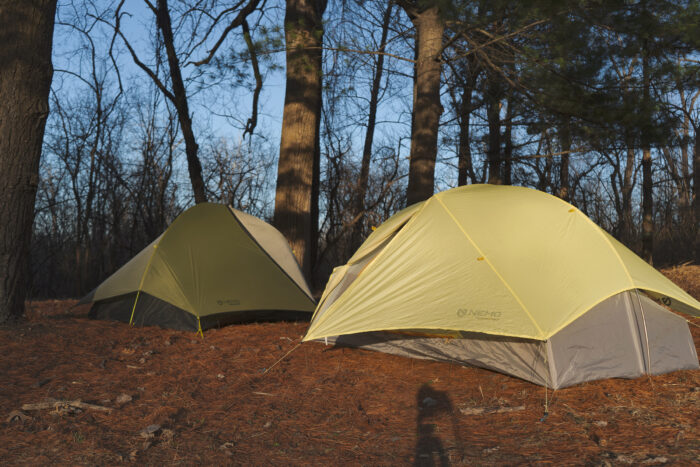
NEMO’s OSMO Fabric
Much of what makes the Mayfly work so well is its proprietary fabric. NEMO is quick to note that OSMO is Bluesign-approved, PFAS-free, 100% recycled, offers four times longer-lasting water repellency, and stretches three times less than nylon when wet. The Mayfly’s OSMO Rainfly is a mix of 15D nylon and 30D polyester.
NEMO’s priorities with OSMO were low-stretch, high strength-to-weight ratio, better water repellency, and abrasion resistance. It isn’t as light and low-stretch as Dyneema. But OSMO is much quieter, wear-resistant, and easier to seam-seal.
It’s not by chance that GearJunkie’s guide to the Best Backpacking Tents has two OSMO tents among its top picks (as of this writing).
Streamlined Setup
Tent setup doesn’t get much easier than with the Mayfly. The poles are pre-bent and everything is color-coded.
When you lay the body out, the way the pole system goes is evident. The tips clip easily into the corners, and the fly is attached to the poles with Velcro straps to reduce wind flap.
Anchor Systems

Head-End ‘Axial Corner’ Anchors
Frankly, NEMO’s new Axial Corner Anchor system might be my favorite tent anchor system. It’s a notable upgrade over its Hornet and Dragonfly tents.
A swiveling socket in a small metallic housing offers a flexible but secure anchor for the tent’s head-end poles. The anchors make tensioning the head-end corners a breeze. They also offer a keyhole system for the rainfly corners. Simply slot the rainfly’s corner peg, twist to lock, and tension.
In windy conditions, the option of anchoring the fly to the spreader poles first, before attaching the internal Velcro straps made life much easier.
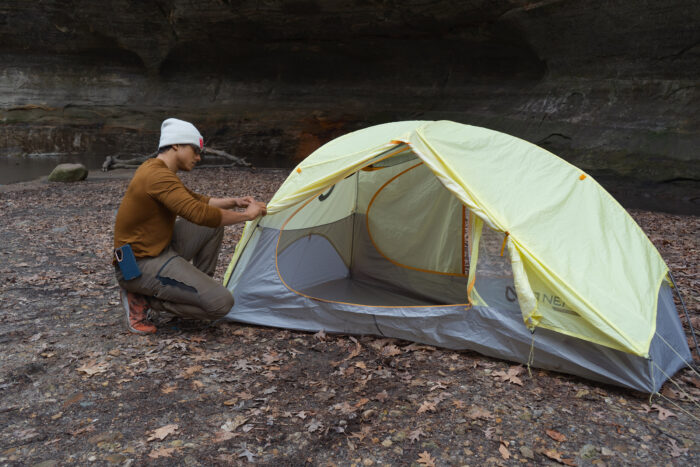
Foot-End Anchors
The foot-end corner anchors are a single length of cord, tethered to the tent corners at a fixed angle. This continuous loop makes staking out the foot-end corners simple. But, on soft, unlevel ground chock full of buried rocks, I wished for a way to tension the lines separately.
Divvy It Up
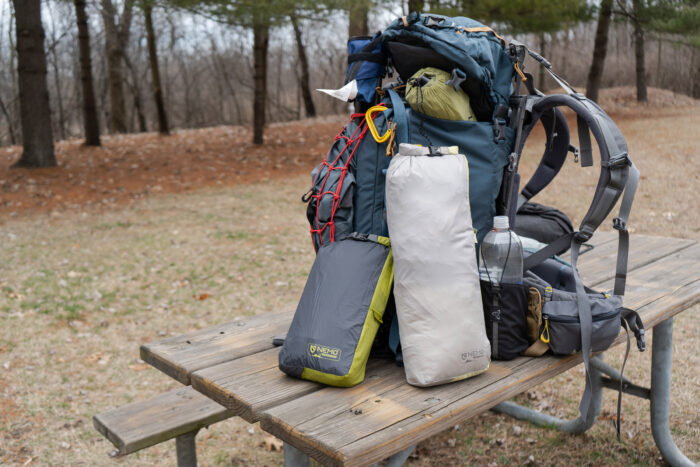
With everything packed together, the Mayfly comes in at 19.5 inches long, 6.5 inches wide, and 3 inches thick and 42 ounces (not including the three extra stakes you’d want to bring for stormy weather). However, as the name implies, the Divvy system makes it easy to divide up the tent.
When the poles and stakes were packed separately, I could squash the tent and rainfly down to a size smaller than a 1.5L Smartwater bottle. The Divvy cube would allow it to fit ergonomically into most 50-70L packs.
Weight
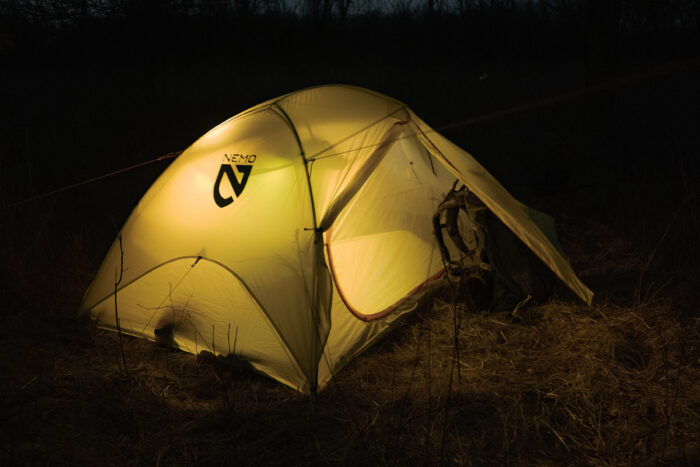
In 2024, any tent over 3 pounds can get easily lumped into the “Good for camping. Could be lighter for long trails” category. For the Mayfly, it depends on what you’re comparing it to.
Held against the likes of the Dragonfly, Marmot Superalloy, Big Agnes Tiger Wall UL 2, and Sea to Summit Alto, the Mayfly comes in anywhere from several ounces to over a pound heavier. However, the Mayfly offers more features at a lower price bracket, with a more robust and sustainable construction than many of the alternatives.
Compare the Mayfly’s weight to other tents on GearJunkie’s guide to the Best Backpacking Tents.
In the Field: Weathering the Storm
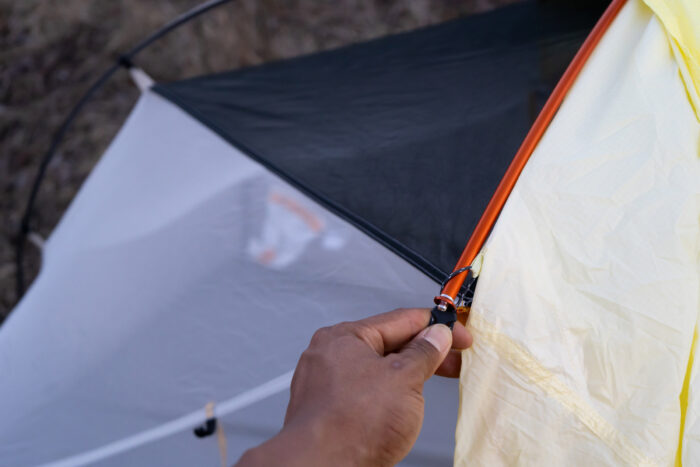
I spent several nights in a flood-prone field during a wave of thunderstorms with 25-35 mph winds. The Mayfly can’t be set up fly-first but with the hatches fully battened, it’s a beast.
Save for its 9.5mm diameter poles and fork hub (notably beefier than the Hornet and Dragonfly), the Mayfly falls right in between its siblings in weather configuration — with six primary stakeouts and just as many optional pullouts.
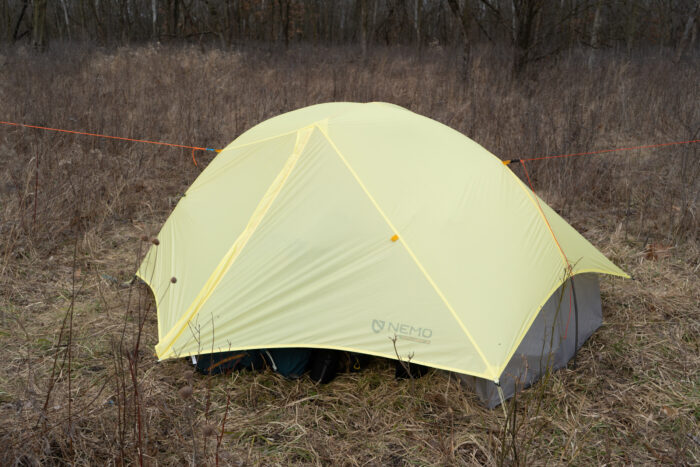
NEMO only includes nine stakes. But fully guyed out and secured at 12 points, my Mayfly stayed rock solid and relatively quiet for the conditions. Only on soft, wet ground, resting my weight on my knees, did I get damp spots.
Even so, the rainfly does trade full coverage for ventilation. Its sides provide a generous vestibule area. However, I found that bags or gear left on bare ground are still prone to getting wet in driving rains.
After several straight days of rain, I found myself wishing that NEMO offered the landing zone vestibule tubs it includes with its Dagger and Dragonfly Bikepack as an optional accessory.
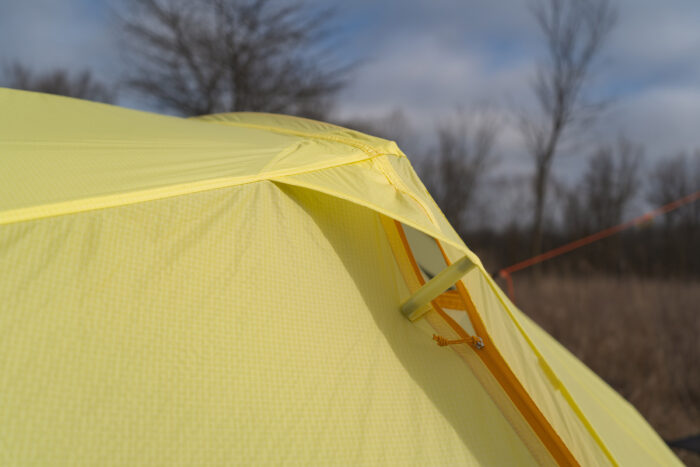
On dry days, either end of the rainfly doors can be tied back. Though for the head end, I found myself wishing for a second, higher tieback to keep the door from slowly unraveling in the wind.
I anticipate even the Mayfly being a sweaty shelter for two in windless summer downpours like we get in Louisiana. In just about everything short of swamp storms, though, the Mayfly is a top contender in ventilation. It can ride out most storms just fine.
Mayfly OSMO Storage Galorage
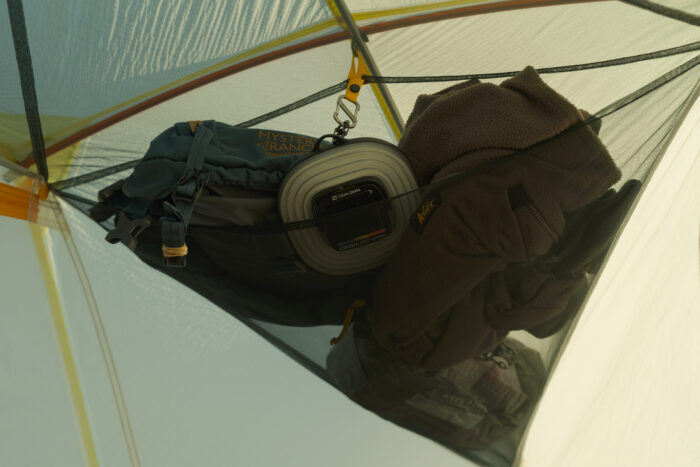
A massive, central, triangular overhead mesh pocket offers at least 15-20 L of storage. This loft alone is genuinely two-person-appropriate, with enough space for pairs of jackets, socks, insulation, etc. At the head end of the tent, there is a long, shallower pocket, ideal for phones, filters, batteries, knives, and other quick-stow items.
On either side of this are two of NEMO’s diffuser pockets, which turn stowed headlamps into soft lanterns.
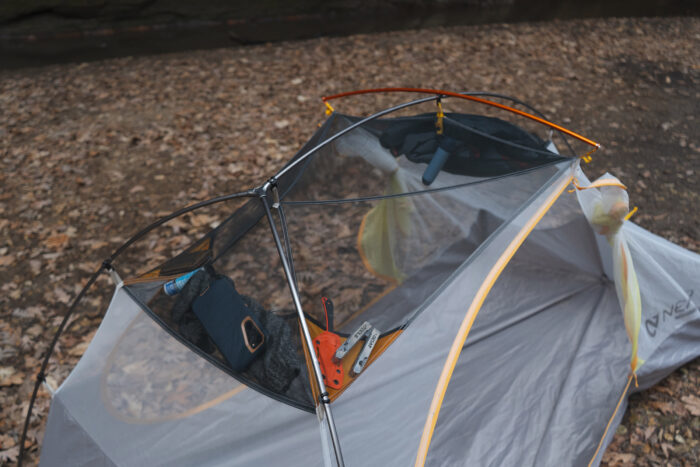
In total, the Mayfly offers seven internal loops for hanging gear, and two external ones hanging from the spreader bars over each door.
On the wettest nights, the external pockets made for a convenient, dry, tick- and critter-free place to hang my shoes.
Two-Person Possibilities
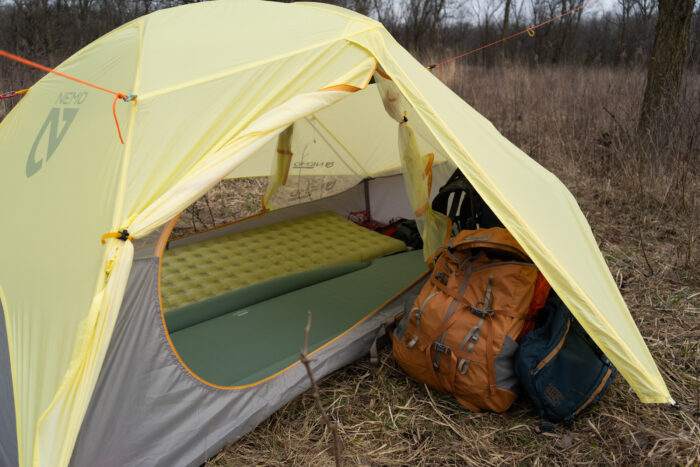
It’s no secret that “two-person” in the camping and backpacking gear industry is short for “suitable for two people in an intimate relationship.” By that standard, the Mayfly lands solidly in the middle of the pack for personal space.
The Mayfly can fit two wide pads if they’re tapered. Some wide/regular combinations will work. Testing some odd couple pairing, I was able to get two of my favorite shoulder season pads, a rectangular 21-inch Near Zero Feather Insulated and a 24-inch REI Co-op AirRail Plus, to fit snugly.
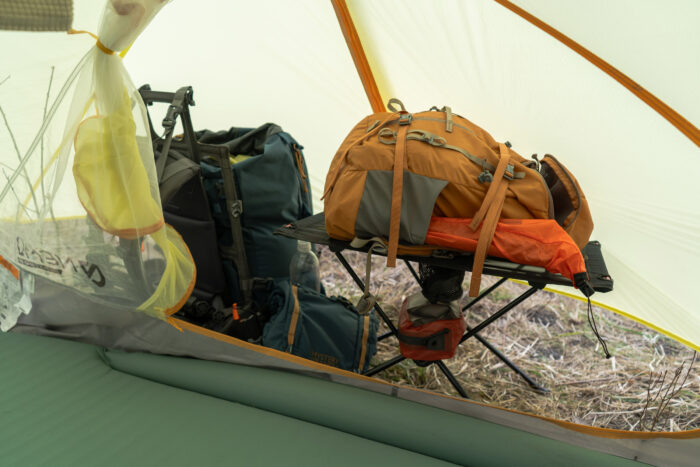
Unlike so many other two-person tents, the Mayfly genuinely offers enough space for two people to sit upright. With over 14 square feet of vestibule area and a 28-square-foot floor, the Mayfly feels genuinely spacious.
Used solo, the NEMO Mayfly OSMO is a palace. As the sort of person who usually sleeps in a spreader bar hammock beneath a 12-foot tarp, a palace is just my speed.
Room for Improvement
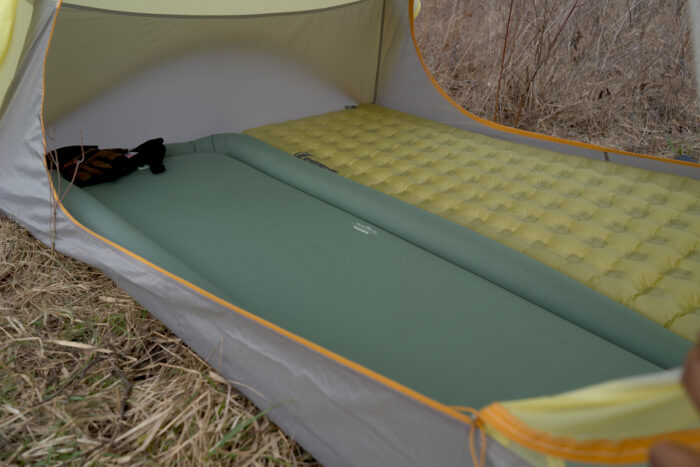
Sans sleeping bags, the tent pinches a bit at the midsection. It was a minor issue. But it was enough to make me miss the Hornet’s solution: a tether between the tent body and rainfly to pull out the mesh.
The Mayfly’s zippers were also fickle. Half the time, the tent door was one-handed, and half the time, it was two. The rainfly zip was snag-prone all of the time, though never badly enough to rip the fabric.
With 17-inch pole segments, the Mayfly isn’t as bikepacking-friendly as several of NEMO’s other tents. Likewise, in 2024, there are lower-budget alternatives that include make-or-break features. Tarptent’s Double Rainbow can easily accommodate two wide, rectangular pads for all of $300. 3F UL’s Floating Cloud 2 offers a choice between swappable three- or four-season tent bodies for $209-222.
Nevertheless, between comfort, quality, durability, storage, sustainability, ease of setup, and OSMO performance, the Mayfly does a lot to clear its own orbit.
NEMO Mayfly OSMO 2P Tent: Comfortable Conclusions
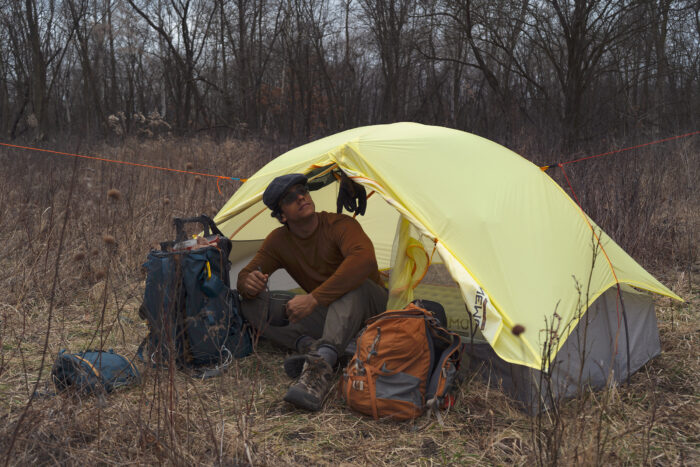
NEMO’s Mayfly falls into a sweet spot, with intelligent compromises. For one person, it’s a palace. For two people, it hangs with the competition in comfort, while coming in cheaper than the usual suspects, and offering considerably better storage.
Ample configurations, robust poles, and a bent toward airflow facilitation make it a well-rounded pick that shrugs off the odd gale. Inclement weather still requires smart setup, especially with regard to tent orientation and gear arrangement in the vestibule.
The Mayfly also feels like it leans heavily on the value of OSMO fabric to outstrip competition from some cheaper alternatives. But OSMO delivers. Its durability and low-stretch waterproofing are impressive.
Overall, the Mayfly perfectly serves the niche of mid-end backpacking tents. It‘s cheaper and more feature-rich than most pricier backpacking tents. It boasts better construction and more sustainable materials than more budget options.
NEMO might consider this tent entry-level. I’d call it a damn good value, and one of my favorite new tents.
